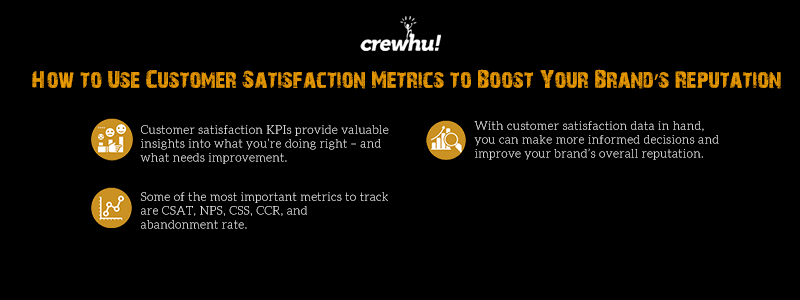How to Use Customer Satisfaction Metrics to Boost Your Brand’s Reputation

Leverage the power of these KPIs to gauge customer satisfaction, improve their experience, and take your brand’s reputation to the next level.
 In today’s fiercely competitive business world, customer satisfaction is an essential component of success. Your customers’ experiences will determine your brand reputation, market position, and long-term sustainability. To gauge and improve customer satisfaction, tracking specific key performance indicators (KPIs) is crucial. These quantifiable measurements provide insights into customer experiences and satisfaction levels. In this comprehensive guide, we will explore the importance of customer satisfaction KPIs, list the most important ones, and share valuable tips for tracking and incorporating these metrics into your business decisions.
In today’s fiercely competitive business world, customer satisfaction is an essential component of success. Your customers’ experiences will determine your brand reputation, market position, and long-term sustainability. To gauge and improve customer satisfaction, tracking specific key performance indicators (KPIs) is crucial. These quantifiable measurements provide insights into customer experiences and satisfaction levels. In this comprehensive guide, we will explore the importance of customer satisfaction KPIs, list the most important ones, and share valuable tips for tracking and incorporating these metrics into your business decisions.
The importance of customer satisfaction KPIs
Customer satisfaction KPIs measure the quality of your products or services and how well they meet or exceed customer expectations. This data provides actionable insights into what you’re doing right and where you need improvement. Most importantly, these metrics can measure customer loyalty, potential revenue growth, and online reputation. In an era where businesses are vying for the attention of an increasingly discerning customer base, customer satisfaction KPIs offer an opportunity to stand out and establish a strong customer-centric culture.
Key customer satisfaction KPIs
That all sounds great, right? But the question remains: Which metrics should you be tracking to derive all of these benefits? The following KPIs will provide valuable insights into the quality of your products, services, and customer interactions, helping you identify areas of strength and opportunities for improvement.
Customer satisfaction score (CSAT)
Using a numerical scale, this KPI measures customer satisfaction with your product or service. CSAT surveys often immediately follow a transaction or interaction. They are a straightforward and widely accepted method of capturing customer sentiment regarding a specific interaction or transaction. A high CSAT score indicates that customers are generally satisfied with your product or service, while a low score suggests a need for improvement.
Net promoter score (NPS)
NPS gauges customer loyalty by asking how likely customers are to recommend your company to others. It segments respondents into promoters (loyal enthusiasts), passives (satisfied but indifferent), and detractors (unhappy customers). A high NPS means you have more advocates than detractors, indicating a high level of customer loyalty and potential for growth.
Customer service satisfaction (CSS)
This KPI assesses the satisfaction level of customers with your customer service department. It can provide vital insights into the efficiency and effectiveness of your customer service crew. You can identify areas of excellence and potential improvements by evaluating how well your representatives resolve issues, communicate with customers, and provide assistance.
Customer churn rate (CCR)
CCR measures the percentage of customers who stop doing business with you during a given period, thus providing a valuable measure of customer retention. Keeping your CCR low should be a priority, as acquiring new customers costs more than retaining existing ones.
Abandonment rate
This KPI calculates the number of customers who abandon a transaction or interaction before completion, providing insights into potential bottlenecks or issues in your sales or support processes. A high abandonment rate might signal a cumbersome checkout process on your website or long wait times in your customer service queues.
Utilizing these KPIs for decision making
Of course, tracking these metrics is just the first step. Now, you have to incorporate that data into your brand’s decision-making process. Here's a step-by-step guide:
Establish clear objectives
Set specific objectives for each KPI that align with your business goals. This ensures a focused approach to monitoring and improving customer satisfaction. For example, consider prioritizing initiatives to enhance customer loyalty programs if your NPS is low. If the abandonment rate is high, streamline your website’s checkout process.
Consistent monitoring
Regularly monitor these metrics to identify improvement areas. Track and analyze the data to uncover trends and patterns. Use this information to guide your decision-making and prioritize areas that require attention.
Cultivate a customer-centric culture
Foster a culture among your crew that recognizes the significance of these metrics. Encourage employees to consider these KPIs in their day-to-day customer interactions. Help them understand how their performance directly influences CSS and overall customer satisfaction. Empower your crew to take ownership of customer satisfaction and prioritize it in their roles.
Tools and training for success
Equip your crew with the necessary tools and training to enhance customer satisfaction. Offer training programs to improve communication skills, problem-solving abilities, and product/service knowledge. Leverage technology such as CRM systems, customer feedback tools, and data analytics platforms to effectively capture, track, and analyze these KPIs so you can make informed decisions.
Strategic planning
Incorporate these KPIs into your strategic planning process. Set goals for improving customer satisfaction metrics and integrate them into your strategic objectives. For example, you can set a target goal for CCR and develop a plan for reaching it. Align your resources and initiatives accordingly to drive meaningful change.
By encouraging your crews to focus on these metrics and providing them with the necessary tools and training, you can empower them to actively contribute to improving customer satisfaction. This, in turn, will positively impact the KPIs that drive your business success.
Fostering a customer-centric mindset and utilizing these KPIs will lead to a more substantial brand reputation, increased customer loyalty, and sustained growth. Embrace the power of these metrics, and watch your organization thrive in the competitive marketplace.
Of course, all of that is easier said than done. Which is why it doesn’t hurt to call in the experts if you need a little help.
Let Crewhu help
In an era of ever-increasing customer expectations and fierce competition, you can leverage customer satisfaction KPIs to stand out from the crowd and establish a solid, customer-focused reputation. Remember, satisfied customers don’t just represent successful sales; they’re your brand ambassadors in the real world. Your customers’ happiness is your success – ensure it's measurable with the right KPIs.
Are you ready to elevate your brand reputation through improved customer satisfaction? It all begins with understanding and applying these crucial KPIs – which is where Crewhu comes in. Our cutting-edge gamification platform can help improve customer and employee satisfaction, allowing you to build better relationships, boost your company’s reputation, and improve your bottom line. For more detailed insights and strategic advice tailored to your business, schedule a demo with our crew today!
Topics: customer satisfaction, Customer experience, KPIs, brand reputation, business metrics, strategic decisions







